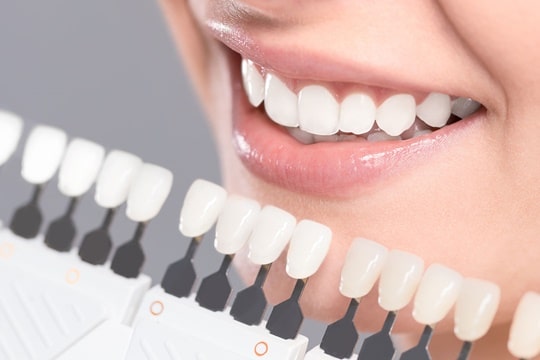Teeth Whitening
Nowadays, teeth whitening is considered one of the most popular cosmetic dentistry treatments available. This is not surprising as teeth whitening is a quick, affordable, and non-invasive way to enhance a smile.
In essence, teeth whitening involves bleaching the teeth in order to lighten them. While it can’t make the teeth extremely white, it can lighten the teeth’s existing colour by several shades.
Typically, the teeth’s natural colour is within the range of light greyish to yellow. However, teeth naturally darkens with age. In addition, accumulation of surface stains from consumption of certain foods or drinks as well as use of tobacco products can also affect the teeth’s appearance.
Why are my teeth discolored?
Below are some of the most prevalent reasons for teeth staining.
- While unknown to many, there is a direct correlation between age and tooth colour. Over the years, teeth can darken as a result of stain accumulation and wear and tear. In most cases, teenagers can experience instant and more dramatic results from teeth whitening. When the teeth start to manifest a yellow cast, dental whitening may entail more effort. For individuals in their forties, the yellow colour of the teeth might turn to brown and might require more dental maintenance. The teeth of people in their fifties may have absorbed more stubborn stains which can be difficult to remove through dental whitening procedures.
- Thinness and translucency. Both genetic traits can become more pronounced as one grows older. While all teeth can exhibit translucency, those who have thick and opaque teeth have an advantage—they look lighter, have more sparkle, and is more responsive to dental bleaching. On the other hand, teeth that are more transparent and thinner have less of the pigment that’s needed for bleaching, making whitening effect less obvious.
- Eating habits. Habitual consumption of tea, cola, coffee, red wine, oranges, carrots, and other deeply-coloured foods and beverages may result in considerable staining overtime. In addition, acidic food like vinegar and other citrus fruits contributes to the erosion of the enamel. As a result, the surface of the teeth can become more transparent and the yellow-coloured dentin will become more apparent.
- Chemicals / drugs. Use of tetracycline during tooth formation can produce a brown or dark grey ribbon stains that can be very difficult to remove. Excessive fluoride consumption can also lead to fluorosis or discolouration marked by faint white marks on the teeth.
- Falls, alongside other injuries can result in sizeable teeth cracks that can collect a huge amount of debris and stains.
- Often attributed to stress, teeth grinding (bruxing, gnashing, etc.) can result in micro- cracking of the teeth and can result in the darkening of the biting edges.
- Smoking habits. Nicotine can leave brownish deposits that can slowly soak into the tooth structure and result in intrinsic discolouration.
- Starting colour. Everyone is born with an inborn teeth colour than can range from yellow brown down to greenish-grey and is not caused by any dental procedure, which can intensify overtime. Generally, yellow brown is more responsive to bleaching compared to green grey.
Teeth Discoloration: What is intrinsic Vs Extrinsic Staining?
There are several alternatives to dentures depending on the specific dental situation and the patient’s preferences. Some alternatives include:
- Dental Implants: These are titanium posts surgically inserted into the jawbone, replacing the root of a missing tooth. They can support individual crowns, bridges, or even full arches of teeth. Implants provide a more permanent and stable solution compared to traditional dentures.
- Dental Bridges: These are fixed prosthetic devices used to replace one or more missing teeth by anchoring onto adjacent natural teeth or dental implants. They can be a good option if the neighbouring teeth are healthy and suitable for support.
- Implant-Supported Dentures can be an excellent solution for patients who find conventional dentures uncomfortable or loose. This hybrid method combines dental implants with a denture to improve stability, retention, and functionality.
The best alternative depends on factors such as the number of missing teeth, oral health, bone density, and individual preferences. Consulting with a dentist or prosthodontist will help determine the most appropriate option based on your specific situation and desired outcomes.
Teeth whitening considerations
In addition to the risks, a few dental caveats should also be considered before undergoing teeth whitening treatment.
- Whitening results won’t be evident until around two weeks after the dental procedure. This should be an important consideration for those patients who will get ceramic restorations and would like to be sure the colour will match that of their newly bleached teeth.
- If porcelain dental veneers, cosmetic bonding, and other dental restorations are part of the treatment plan, they should not be placed until two weeks has passed after whitening. This is to ensure function, proper adhesive bonding, and shade matching is achieved for an effective whitening of teeth.
- To prevent the technicolour effect, tooth-coloured restorations might require replacement after bleaching.
- Teeth whitening is not recommended for nursing or pregnant women as the likely impact of swallowed bleach on the fetus is still unknown.
What are the different types of denture materials?
A number of bleaching products and techniques are now available to patients. However, dentists often use the following methods to whiten the teeth:
- Vital bleaching. This type is often done on the “living” teeth and is typically the option for teeth stained by food or tobacco. It is also often the alternative for teeth that has darkened with age.
- Non-vital bleaching. This type of bleaching is done on teeth that are not “alive.” For instance, for teeth that has been discoloured because of root canal, non-vital bleaching is recommended to lighten the teeth from the inside out.

Teeth Whitening Risks
As long as done by a dentist, teeth whitening treatments are considered safe. However, the procedure also comes with certain risks like:
- Bleaching can cause short-term sensitivity to pressure, touch, and temperature. Sensitivity is most likely to occur when a higher concentration of bleach is used. Some patients may also experience zingers or spontaneous shooting pains in the middle of the front teeth. Individuals who are at greater risk for whitening sensitivity are those with significant cracks in their teeth, gum recession, or those with leakage secondary to faulty restorations. Fortunately, sensitivity due to teeth bleaching won’t last longer than a day or two.
- Technicolour teeth. Restorations like dental crowns, veneers, or bonding won’t be affected by bleach and therefore will maintain their default colour white the rest will be whitened. The result is what is referred to by many as technicolour teeth.
- Gum irritation. At least half of those who use peroxide whiteners experience a degree of gum irritation from contact with the trays or from the bleach concentration. Once the bleach has dissipated or the peroxide concentration has lowered, the irritation will eventually disappear.
Teeth Bleaching Methods
Generally, there are three methods available when bleaching teeth. The method that will be used will depend on a few key factors like the number of teeth that needs bleaching and how badly they are discoloured or stained.
Depending on what’s best for the patient, the dentist may recommend the following:
- Using and putting a special bleach on the stained teeth and using light or heat to begin the bleaching action.
- Wearing a mouthguard that is custom-made and filled with a special bleach.
- Brushing the teeth using a special bleach mixed with the toothpaste.
Shade guides
Before and after teeth colour is usually measured using shade guides. Shade guides are hand-held displays of teeth colours. They are also used when choosing crowns as well as other restoration shades.
The standard-setter among the shade guides is the Vitapan Classic Shade Guide. This guide incorporates 16 shades, arranged systematically from light to dark and is divided into four colour groups. It also comes with a universal tooth-colour terminology.
While whitening can lighten the colour of the teeth by nine (or more) shades, those who have their teeth bleached can expect to see a change of two to seven shades.
Teeth Whitening Options
While teeth is not meant to be completely white, many people still want a brighter smile. In line with this, a vast range of teeth whitening options has become available to consumers. These products however fall into two primary categories: bleaches and surface whiteners.
- Surface whiteners. These kind of products make use of special abrasives to enhance the product’s ability to get rid of surface stains. Majority of the products that fall in this category are either chewing gums or toothpastes. Since the special abrasives in these type of whitening products are usually finer versions of those used in regular toothpastes, it is very unlikely for them to cause excessive tooth wear. However, the product’s effectiveness is generally limited to the removal of surface stains.
- Most of the bleaching products available are peroxide-based and can effectively alter the colours of the teeth. However, not all teeth discolourations will respond to teeth-bleaching treatments. It is recommended that those who are contemplating having their teeth bleached should consult with a dentist so cause of the teeth discolouration is determined. It is also needed so that dentist can gauge if teeth bleaching is indeed the best option. This is especially important for patients with root canal treatments, crowns, fillings, or those with really dark stains on the anterior teeth.
















